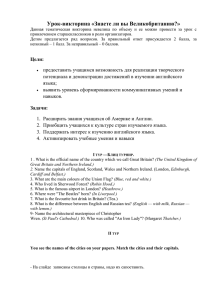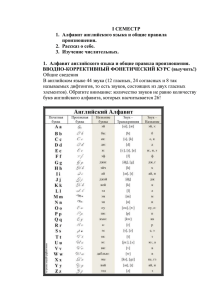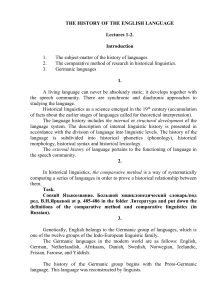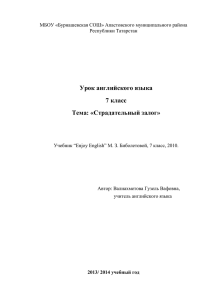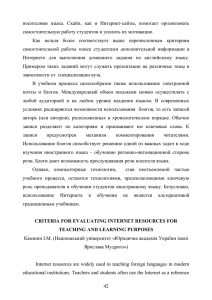ПЛАН САМОСТІЙНИХ ЗАНЯТЬ № теми Тема заняття та його
реклама
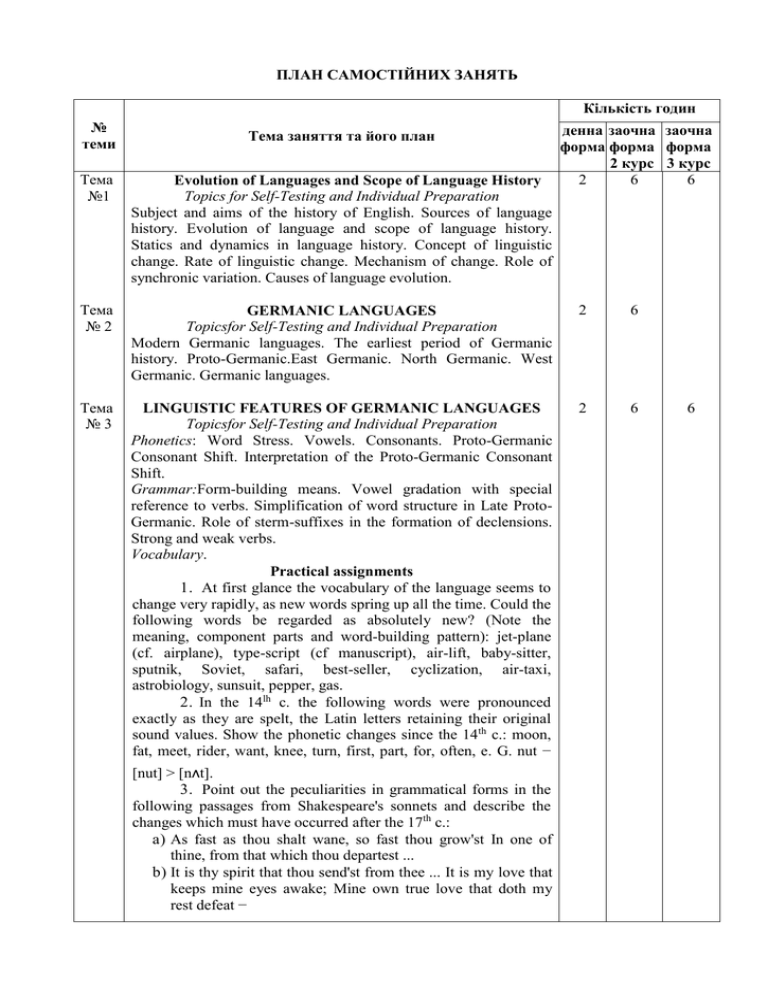
ПЛАН САМОСТІЙНИХ ЗАНЯТЬ
Кількість годин
№
теми
Тема заняття та його план
денна заочна заочна
форма форма форма
2 курс 3 курс
2
6
6
Тема
№1
Evolution of Languages and Scope of Language History
Topics for Self-Testing and Individual Preparation
Subject and aims of the history of English. Sources of language
history. Evolution of language and scope of language history.
Statics and dynamics in language history. Concept of linguistic
change. Rate of linguistic change. Mechanism of change. Role of
synchronic variation. Causes of language evolution.
Тема
№2
GERMANIC LANGUAGES
Topicsfor Self-Testing and Individual Preparation
Modern Germanic languages. The earliest period of Germanic
history. Proto-Germanic.East Germanic. North Germanic. West
Germanic. Germanic languages.
2
6
Тема
№3
LINGUISTIC FEATURES OF GERMANIC LANGUAGES
Topicsfor Self-Testing and Individual Preparation
Phonetics: Word Stress. Vowels. Consonants. Proto-Germanic
Consonant Shift. Interpretation of the Proto-Germanic Consonant
Shift.
Grammar:Form-building means. Vowel gradation with special
reference to verbs. Simplification of word structure in Late ProtoGermanic. Role of sterm-suffixes in the formation of declensions.
Strong and weak verbs.
Vocabulary.
Practical assignments
1. At first glance the vocabulary of the language seems to
change very rapidly, as new words spring up all the time. Could the
following words be regarded as absolutely new? (Note the
meaning, component parts and word-building pattern): jet-plane
(cf. airplane), type-script (cf manuscript), air-lift, baby-sitter,
sputnik, Soviet, safari, best-seller, cyclization, air-taxi,
astrobiology, sunsuit, pepper, gas.
2. In the 14lh c. the following words were pronounced
exactly as they are spelt, the Latin letters retaining their original
sound values. Show the phonetic changes since the 14th c.: moon,
fat, meet, rider, want, knee, turn, first, part, for, often, e. G. nut −
2
6
[nut] > [nʌt].
3. Рoint out the peculiarities in grammatical forms in the
following passages from Shakespeare's sonnets and describe the
changes which must have occurred after the 17th c.:
a) As fast as thou shalt wane, so fast thou grow'st In one of
thine, from that which thou departest ...
b) It is thy spirit that thou send'st from thee ... It is my love that
keeps mine eyes awake; Mine own true love that doth my
rest defeat −
6
c) Bring me within the level of your frown. But shoot not at me
in your wakened hate!
4. Comment on the following quotations from the works
of prominent modern linguists and speak on the problems of
linguistic change:
a) One may say with R. Jakobson, a little paradoxically, that a
linguistic change is a synchronic fact. (A. Sommerfelt).
b) Visible change is the tip of an iceberg. Every alteration that
eventually establishes itself, had to exist formerly as a
choice. This means that the seeded for variation in time is
simply the whole landscape of variation in space. (D.
Bolinger)
c) The structure of language is nothing but the unstable balance
between the needs of communication, which require more
numerous and more specific and more frequently occurring
units. (A. Martinet)
"That two forms, the new and the old, can occasionally exist in
wholly free variation is a possibility that has not yet been disproved
but, as Bloomfield rightly remarked "when a speaker knows two
rival forms, they differ in connotation, since he has heard them
from different persons under different circumstances". (M.
Samuels).
5. Account for the following place names: Germany,
Saxony, Bavaria, Anglia, Thuringia, Swabia, Gothenburg,
Gothland, Burgundy, Allemagne (T"r for Germany), Gotha,
Jutland, France, Frankfurt, Normandy, Anglesea, England.
6. Analyse the shifting of word stress in word-building
and form-building and point out the words which can illustrate the
original Germanic way of word accentuation: read, reading, reread, readable; bear v., bearer, unbearable, satisfy, satisfaction,
unsatisfactorily; circumstance, circumstantial, circumstatiality.
7. Explain the sound correspondence in the following
parallels from Germanic and non-Germanic languages (the sounds
are italicized).
R боль
OE balu 'mischief';
R cоль
G Salz 'salt'
L gena
OE cm [kin] (NE fee)
L pecus
GtfdXhu, OEfeoh
(NE fee)
R нагой '
NE naked, G nackt
R приятель
NE frіend
R дерево
Gt triu, NE tree
L domare
NE tаme
8. Analyse the consonant correspondences in the
following groups of words and classify the words into Germanic
and non-Germanic: foot, pedal, pedestrian; twofold double,
doublet, twin, brotherly, fraternal; tooth, dental, dentist; canine,
hound; hearty, cordial; three, trinity; decade, decimals, ten;
agriculture, acre; agnostic, know; tame, domestic.
9. Why can examples from the Gothic language often be
used to illustrate the PG state while OE and OHG examples are
less suitable for the purpose?
2
10. Classify the following Mod E verbs into descendants of
the strong verbs and the weak verbs (Note that the PG-d-became d
or t in English): sing, live, rise, look, answer, speak, run, shake,
warn.
11. Prove that suppletion is an ancient way of formbuilding which goes back to the epoch of the PIE parent-language.
12. We can infer a good deal about the culture of the
people, their s structure and geographical conditions from the
words of their language. Wha be reconstructed of the life of the
Teutons from the following list of English \v whose cognates are
found in other Germanic languages: borough, brew, t cliff, earl,
east, lore, king, knead, north, sea, seal, ship, south, steer, stranc
were, west, whale, wheat?
ЛІТЕРАТУРА
1. Верба Л.Г. Історія англійської мови. Посібник для студентів
та викладачів вищих навчальних закладів. – Вінниця:
НОВА КНИГА, 2006. – 296 с.
2. Расторгуева Т.А. История английского языка. – М., 2005. – 348 с.
Тема
№4
ДОДАТКОВА ЛІТЕРАТУРА
1. Аракин И.Д. Очерки по истории английского языка. – М.,
1955.
2. Бруннер К. История английского языка. Перев.с нем. – М.:
Иностранная литература, т. I, II, 1956.
3. Арсеньева М.Г., Балашова С.П., Берков В.П., Соловьева Л.Н.
Введение в германскую филологию. – М., 1980.
4. Иванова И.П., Чахоян Л.П. История английского языка. –
М., 1976.
5. Ильиш Б.А. История английского языка. – Л., 1973.
6. Смирницкий А.И. История английского языка. Курс лекций.
– М., 1965.
Chronological Divisions in the History of English.
Old English. Historical background
Topicsfor Self-Testing and Individual Preparation
Pre-Germanic Britain. Germanic settlement of Britain. Beginning
of English. Events of external history between the 5th and 11th c.
Old English dialects. Linguistic situation.
2
6
6
Тема
№5
OLD ENGLISH WRITTEN RECORDS
Topicsfor Self-Testing and Individual Preparation
Runic Inscriptions. Old English Manuscripts. Principal Old English
Written Records.
2
6
8
Тема
№6
OLD ENGLISH ALPHABET AND PRONUNCIATION
2
6
8
Topicsfor Self-Testing and Individual Preparation
Old English alphabet. The rules of pronunciation.
Practical assignments
1. What languages were spoken in the British Isles prior to
the Germanic invasion? Which of their descendants have survived
3
today?
2. What historical events account for the influence of Latin
on OE?
3. Describe the linguistic situation in Britain before and
after the Germanic settlement.
4. Explain the origin of the following place names:
Britain, Scotland, Great Britain, Bretange, England, Sussex,
Essex, Middlessex, Wess ex, Northumberland\ Wales, Cornwall.
5. The OE language is often called Anglo-Saxon. Why is
this term not full} justified?
Why can we regard the group of OE dialects as a single language
despite their differences, which continued to grow in later OE?
What binds them together?
ЛІТЕРАТУРА
1. Верба Л.Г. Історія англійської мови. Посібник для студентів
та викладачів вищих навчальних закладів. – Вінниця:
НОВА КНИГА, 2006. – 296 с.
2. Расторгуева Т.А. История английского языка. – М., 2005. –
348 с.
Тема
№7
ДОДАТКОВА ЛІТЕРАТУРА
1. Аракин И.Д. Очерки по истории английского языка. – М.,
1955.
2. Бруннер К. История английского языка. Перев.с нем. – М.:
Иностранная литература, т. I, II, 1956.
3. Арсеньева М.Г., Балашова С.П., Берков В.П., Соловьева Л.Н.
Введение в германскую филологию. – М., 1980.
4. Иванова И.П., Чахоян Л.П. История английского языка. –
М., 1976.
5. Ильиш Б.А. История английского языка. – Л., 1973.
6. Смирницкий А.И. История английского языка. Курс лекций.
– М., 1965.
OLD ENGLISH PHONETICS
Topicsfor Self-Testing and Individual Preparation
Old English phonetics.Word Stress.
Origin of Old English vowels.Changes of stressed vowels in
Early Old English. Independent changes. Development of
monophthongs. Development of diphthongs. Assimilative vowel
changes: breaking and diphthongisation. Palatal mutation.
Changes of unstressed vowels in Early Old English. Old English
vowel system (9th-10th c.).
Origin of Old English consonants.Consonant changes in prewritten periods. Treatment of fricatives. Hardening. Rhotacism.
Voicing and devoicing. West Germanic gemination of consonants.
Velar consonants in Early Old English. Growth of new phonemes.
Loss of consonants in some positions. Old Englishconsonant
system.
Practical assignments
1. Comment on the phonetic status of OE short
diphthongs (give your reasons why they should be treated as
4
2
6
6
phonemes or as allophones).
2. Account for the difference between the vowels in OE
past, eal and monn, all going back to PG words with [a] (cf Gt
pata; manna, alls).
3. Account for the interchange of vowels in OE dse as, da
as (NE day - Dat. sg and Nom. pi); badian (NE bath, bathe).
4. Account for the difference between the root-vowels in
OE and in parallels from other OG languages:
Gt langiza, OE lenra (NE longer)-, Gt marei, OHG meri,
OE mere (NE obs. mere ,lake'); Gt sandian, OE sendan (NE
send)-, Gtubils, OE yfel (NE evil)-, Gt be-laibian, OE laefan (NE
leave); Gt. baugian, OE by an, ble ran ('bend'); Gtfulljan
(NEfdl)\Gt laisjan - OE laeran 'teach'.
5. Explain the term "mutation" and innumerate the
changes referred to mutations in Late PG and Early OE. What do
they all have in common?
6. Define the sound values of the letters f, d, s and
comment on the system of OE consonant phonemes:
OE heofon, faran, e-faran, hsefde, offrung, ofer (NE heaven, fare,
had, offering, over)-, одде, oder, Nord, danne ('or', NE other,
North, then)-, sae, wisse, ceosan, ceosan, ceas (NE sea, 'knew',
choose, chose).
ЛІТЕРАТУРА
1. Верба Л.Г. Історія англійської мови. Посібник для студентів
та викладачів вищих навчальних закладів. – Вінниця:
НОВА КНИГА, 2006. – 296 с.
2. Расторгуева Т.А. История английского языка. – М., 2005. –
348 с.
ДОДАТКОВА ЛІТЕРАТУРА
1. Аракин И.Д. Очерки по истории английского языка. – М.,
1955.
2. Бруннер К. История английского языка. Перев.с нем. – М.:
Иностранная литература, т. I, II, 1956.
3. Арсеньева М.Г., Балашова С.П., Берков В.П., Соловьева Л.Н.
Введение в германскую филологию. – М., 1980.
4. Иванова И.П., Чахоян Л.П. История английского языка. –
М., 1976.
5. Ильиш Б.А. История английского языка. – Л., 1973.
6. Смирницкий А.И. История английского языка. Курс лекций.
– М., 1965.
Тема HISTORICAL BACKGROUND FROM THE 11ΤΗ TO 15TH C.
№ 8, 9
LINGUISTIC SITUATION. WRITTEN RECORDS
Topicsfor Self-Testing and Individual Preparation
Economic and social conditions in thellth-12th c.Effect of the
Scandinavian invasions.The Norman conquest. Effect of the
Norman conquest on the linguistic situation.Early Middle English
dialects. Extension of English territory.Early Middle English
written records.Late Middle English. Reestablishmentof English as
the language of the state and literature. Dialects in Late Middle
English. The London dialect.Written records in Late Middle
5
2
12
16
English. The age of Chaucer.Principal Middle English written
records.
Practical assignments
1. Compare the position of the Old Scandinavian and AngloNorman (French) in Early ME (comment on the geographical,
social and linguistic differences).
2. Account for the shift of the dialect type of the speech of
London in the 14th c. Why is the name "English" language more
justified than "Anglo-Saxon" or "Saxon" though in the OE period
one of the Saxon dialects, West Saxon, was the main form of
language used in writing?
Тема
№ 10
DEVELOPMENT OF THE NATIONAL LITERARY
ENGLISH LANGUAGE (16TH-19TH C.)
Topicsfor Self-Testing and Individual Preparation
Economic and Political Unification. Conditions for Linguistic
Unity.Progress of culture. Introduction of printing. Foreign contacts
in the Early New English period.Expansion of English over the
British Isles.Flourishing of literature in Early New English
(Literary Renaissance). New sources of information about the
language. Private Papers. Didactic compositions. Establish-mentof
the Written Standard.Normalising tendencies. Grammars and
dictionaries in the late 17th and 18th c. Growth of the Spoken
Standard.The modern period. Varieties of English in Britain in the
19th and 20th c. Geographical expansion of the English language
from the 17th to 19th c. English outside Great Britain.
2
6
8
1
6
8
Practical assignments
1. Describe the events of external history which favoured the
growth of the national literary language.
2. Can the evolution of language be controlled by man? Recall
the efforts made by men-of-letters in the "Normalisation period" to
stop the changes and improve the language.
3. Comment on the following quotations:
J. Hart (1570): "The flower of the English tongue is used in
the Court of London."
G. Puttenham(1589): "... ye shall therefore take the usual
speach of the Court, and that of London within IX myles, and not
much above. I say this but that in every shyre of England there be
gentlemen and others that speake but specially write as good
Southerne as w of Middlesex or Surrey do, but not the common
people of every shire..."
4. Discuss the social and geographical basis of the literary
English language.
Тема
№ 11
SPELLING CHANGES IN MIDDLE ENGLISH.
RULESOFREADING
Topicsfor Self-Testing and Individual Preparation
Spelling changes in Middle English. Rules of Reading Middle
English.
6
Practical assignments
1. Analyze the relationships between the letters and
sounds in the given extract and say in which instances the ME
spelling system was less phonetic - and more conventional - than
the OE system.
2. Read the following ME words and explain the
employment of the italicized letters:
certainly, pacient, carrie, Јillen (NE certainly, patient, carry, kill);
geste, gold, (NE jest, gold); was, seson, e.se, sory (NE was,
season, ease, sorry); other, th'mken, the, that, nameless, both (NE
other, think, the, that, nevertheless, both); a/ere, ег^егу,fight, thief,
very (NE affair, every, fight, thief very); yonge,sonne, not, hose
(NE young, sun, not, hose); mows, low, loud,toun, how (NE
mouse, low, loud, town, how); knowen, whether, stmwnge, what,
knyght, taughte (NE know,whether, strange, what, knight, taught).
ЛІТЕРАТУРА
1. Верба Л.Г. Історія англійської мови. Посібник для студентів
та викладачів вищих навчальних закладів. – Вінниця:
НОВА КНИГА, 2006. – 296 с.
2. Расторгуева Т.А. История английского языка. – М., 2005. –
348 с.
ДОДАТКОВА ЛІТЕРАТУРА
1. Аракин И.Д. Очерки по истории английского языка. – М.,
1955.
2. Бруннер К. История английского языка. Перев.с нем. – М.:
Иностранная литература, т. I, II, 1956.
3. Арсеньева М.Г., Балашова С.П., Берков В.П., Соловьева Л.Н.
Введение в германскую филологию. – М., 1980.
4. Иванова И.П., Чахоян Л.П. История английского языка. –
М., 1976.
5. Ильиш Б.А. История английского языка. – Л., 1973.
6. Смирницкий А.И. История английского языка. Курс лекций.
– М., 1965.
Тема EVOLUTION OF THE SOUND SYSTEM FROM THE 11TH
№ 12
TO 18TH C.
Topicsfor Self-Testing and Individual Preparation
Word stress in Middle English and Early New English. Vowel
Changes in Middle English and Early New English: Unstressed
vowels. Main trends in the changes of stressed vowels.
Quantitative vowel changes in Early Middle English.
Qualitative vowel changes in Early Middle English: Development
of monophthongs. Development of diphthongs.System of vowels in
Late Middle English. The Great Vowel Shift.Some interpretations
of the Great Vowel Shift. Changes of shortvowels in Early New
English. Growth of long monophthongs and diphthongs in Early
New English due to vocalisation of consonants.
Quantitative vowel changes in Early New English:Principal
changes of vowels in Middle English and Early New English.
Evolution of consonants in Middle English and Early New English:
Growth of sibilants and affricates.Treatment of fricative consonants
7
1
6
8
in Middle English and Early New English. Loss of consonants.
Historical foundations of Modern English spelling. Main historical
sources of modern spellings.
Practical assignments
1. Prove, by instances of phonetic changes, that ME was
divided into a number of dialects.
2. Point out some changes preceding the Great Vowel
Shift which display the same directions of evolution.
3. Confer the system of vowels in OE with that in Late ME
and say in which respects it has become less symmetrical.
4. Account for the interchange of vowels in NE child –
children, wild – wilderness, bewilder (ME bewildren), behind –
hindrance; in О El the root vowel in these words was [і].
5. Give a historical explanation of different spellings of
the following homophones: NE son, sun; meet, meat; see, sea;
rein, rain; vein, vain; soul, sole; main, mane; cease, seize; flour,
flower; so sow; law, lore; bare, bear; root, route; or, oar; rode,
road. Were all these pairs homophones in ME?
6. Explain from a historical viewpoint the pronunciation
of the following words with the letter g: good, again, general,
change, regime.
7. Account for the difference in the sound values ofth, /in
the following words: son, busy, wisdom, mouse, east, diverse
(MEdeserven [do'servan]), observe, resemble (MEresemblen
[ra'sembta]), books (ME bookes ['bo:kas]), robes (ME robes
['ro:bss]), dresses, thousand, threat, thou, the, mouth, mouths (ME
mouthes ['rmr.des]), they, of, fair, fence.
8. Explainthe origin of different sound values of the
following digraphs: ea in seat, dead: ie in chief, lie: on in pound,
soup, rough; o\v in sow and how. Why do they indicate other
sounds before r, e. G. dear, pear; pier, bier; pour, sour; lower,
power.
9. Recallthe development of OE [у, y:] and explain the
differences in the pronunciation and spelling of merry, hill, busy,
buy, evil, bury (all descending from OE words with short [y]) and
sleeve, fist, mice, sundry (descending from OE words with long
[y]).
10. Show how modern spelling can help to reconstruct
the phonetic history of the words; use the following words as
examples: NE drive, cast, cart, cord, ant, warn, bird, beard, burn,
certain, first, nun, none, bloody, bony, knee, gnat, often, limb.
11. Give the modem descendants of the following
words, which developed in accordance with regular phonetic and
spelling changes: OE hind, spedi, dust, sceaft, scTnan, snawan,
rzedan, hearm, sceal, wearm, сёар [к'], butere, boc, bat, metan,
mёtan, hund, hundred, hwzet, tun, steorfan, prssd, smoca, drlfan,
bana, с1ёор, ад.
12. Reconstruct the phonetic changes so as to prove that
the words have descended from a single root: NElisten and loud;
merry and mirth; deep and depth; foul and filth; husband and
house; long and length; sheep and shepherd; tell, tale and talk;
8
thief and theft; gold, gild and yellow; person and parson.
13. Account for the mute letters in late, sight, wrong,
often, bomb, autumb, course, knowledge, honor, what, whole,
guest, pneumonia, psalm.
14. Try to account for the appearance of mute letters in
the following words: NE thumb (OE puma) – NE house (OEhus)\
NE delight (MEdelite) – NE horse (OE hors)\ NE limb (OElirn);
NE whole (OE hat).
ЛІТЕРАТУРА
1. Верба Л.Г. Історія англійської мови. Посібник для студентів
та викладачів вищих навчальних закладів. – Вінниця:
НОВА КНИГА, 2006. – 296 с.
2. Расторгуева Т.А. История английского языка. – М., 2005. –
348 с.
ДОДАТКОВА ЛІТЕРАТУРА
1. Аракин И.Д. Очерки по истории английского языка. – М.,
1955.
2. Бруннер К. История английского языка. Перев.с нем. – М.:
Иностранная литература, т. I, II, 1956.
3. Арсеньева М.Г., Балашова С.П., Берков В.П., Соловьева Л.Н.
Введение в германскую филологию. – М., 1980.
4. Иванова И.П., Чахоян Л.П. История английского языка. –
М., 1976.
5. Ильиш Б.А. История английского языка. – Л., 1973.
6. Смирницкий А.И. История английского языка. Курс лекций.
– М., 1965.
Тема
EVOLUTION OF THE GRAMMATICAL SYSTEM FROM
№ 13
THE 11TH TO 18TH C.
Topicsfor Self-Testing and Individual Preparation
Parts of speech, means of form-building, main trends of
development.
The noun: Decay of noun declensions in Early Middle English.
Grammatical categories of the noun.
The pronoun: Personal and possessive pronouns.Demonstrative
pronouns. Development of articles. Other classes of pronouns
(interrogative, indefinite, relative).
The adjective: Decay of declensions and grammatical
categories.Degrees of comparison. Development of nominal
grammatical categories.
The Verb: Finite foms. Number. Person. Mood. Tense. Verbals.
Infinitive. Participle. The Development of the Gerund.
Practical assignments
1. Compare the historical productivity of different form-building
meai synthetic (inflections, sound interchanges), analytical,
suppletive.
2. Describe the sources of the modern pi forms of nouns and spread
of the ending~(e)s.
3. Compare the development of case and number in nouns,
adjectives and pronouns.
9
1
6
8
4. Illustrate the process of replacement by tracing the history of the
pronoushe, they, their, him, you, its.
5. Comment on the forms of pronouns in the following quotations:
'tis better thee without than he within; Between who?; Nay, you
need n fear for us; Loving offenders, thus I will excuse ye.
(Shakespeare).
6. What is the connection between the growth of articles, the
history pronouns and the decline of adjectival declensions?
Тема
№14
DEVELOPMENT OF THE ENGLISH VOCABULARY
FROM THE 12TH TO 20TH C.
Topicsfor Self-Testing and Individual Preparation
Types and sources of changes. Scandinavian influence on the
vocabulary.French influence on the vocabulary in Middle English.
Borrowings from classical languages, with special reference to the
age of the Renaissance. Borrowings from contemporary Languages
in New English.
History of word formation with special reference to the 15th − 17th c.
Word derivation. Sound interchanges. Word stress. Prefixation.
Native prefixes. Borrowed prefixes. Suffixation.Native suffixes.
Borrowed suffixes. Conversion. Word composition in Middle
English and Early New English. Simplification. Back formation.
Semantic changes in the vocabulary.
Practical assignments
1. Comment on the English-Scandinavian etymological
doublets – skirt – shirt; scatter – shatter.
2. Compare the French and Scandinavian influence on the
Middle English vocabulary (linguistic, geographical and social
aspects; the number, nature and spheres of borrowings).
3.
Comment on the following fragment from IVANHOE
by W. Scott: 'Why, how call you those grunting brutes running
about on their four legs?' demanded Wamba.
'Swine, fool, swine, ...'
'... And swine is good Saxon,' said the Jester; 'but how call
you the sow when she is flayed, and drawn, and quartered, and
hung up by the heels, like a traitor?'
'Pork,' answered the swine-herd.
'I am very glad every fool knows that too,' said Wamba,
'and pork, I think, is good Norman-French; and so when the brute
lives, and is in charge of a Saxon slave, she goes by her Saxon
name; but becomes a Norman and is called pork, when she is
carried to the Castle hall to feast among the nobles; what dost thou
think of this, friend Gurth, ha?'
4. Describe the semantic changes exemplified by the
following words; point out instances of metonymic and
metaphoric, narrowing and widening of meaning:
NE
Earlier meanings (OE or ME)
aunt
'father's sister'
bird
'young fowl'
cany
'transport by cart'
corn
'any grain'
10
1
6
8
fare
'travel, go'
hound
'dog'
5. Comment on the following statement made by S. Johnson
in hie DICTIONARY: "He shall seldom err who remembers that
when a verb has a participle distinct from its preterite as write,
wrote, written, that distinct participle is more proper and elegant, as
the book is written is better than the book is wrote though wrote
may be used in poetry..."
6. Make a list of verb inflections in MOD E and trace their
origin (show their grammatical and dialectal sources).
7. Why would it be incorrect to apply the terms "strong" and
"weak" to Mod E standard and non-standard verbs?
8. Describe the development of the principal forms of the
following verbs: OEfedan w„wepan str.,ascian w.,sincan, windan
str.
9. Point out traces of OE preterite-present verbs in modern
modal verbs.
10. Have all the phrases consisting of have plus Part. II, be
plus Part. I and shall/will plus Inf. Become grammatical forms?
Describe their histories as instances of splitting.
11. Use the following quotations to describe the history of
Continuous forms:
It was not for nothing that my nose fell a-bleeding on Black
Monday.(Shakespeare)
The clock struck ten while the trunks were carrying down...
(J. Austen, late 18th c.)
12. What developments in English syntax can be illustrated
by the following quotations:
"Madam, my interpreter, what says she? Whereupon dо you
look?" "Not from the stars do I my judgment pluck. And yet
methinks I have astronomy..."
"How likes you this play, my lord?" (Shakespeare).
13. Recall some instances of grammatical changes which
involve several linguistic levels: morphological, syntactic,
phonetic, lexical.
14. In this "theory of progress" O. Jespersen asserted that
English, being an analytical language, was more advanced than
other languages. Consider and criticise some of his arguments:
The forms are generally shorter, thus involving less
muscular exertion and requiring less time for enunciation.
There are not so many of them to burden the memory.
Their formation is much more regular.
Their syntactic use also presents fewer irregularities.
The clumsy repetitions known under of control have
become superfluous.
A clear and unambiguous understanding is secured
through a regular word order.
ЛІТЕРАТУРА
1. Верба Л.Г. Історія англійської мови. Посібник для студентів
та викладачів вищих навчальних закладів. – Вінниця:
11
НОВА КНИГА, 2006. – 296 с.
2. Расторгуева Т.А. История английского языка. – М., 2005. –
348 с.
ДОДАТКОВА ЛІТЕРАТУРА
1. Аракин И.Д. Очерки по истории английского языка. – М.,
1955.
2. Бруннер К. История английского языка. Перев.с нем. – М.:
Иностранная литература, т. I, II, 1956.
3. Арсеньева М.Г., Балашова С.П., Берков В.П., Соловьева Л.Н.
Введение в германскую филологию. – М., 1980.
4. Иванова И.П., Чахоян Л.П. История английского языка. –
М., 1976.
5. Ильиш Б.А. История английского языка. – Л., 1973.
6. Смирницкий А.И. История английского языка. Курс лекций.
– М., 1965.
Усього
12
24
84
102
